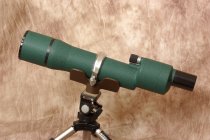Hi Folks!
For a decade, maybe two, my primary spotting scope has been an ancient Bausch & Lomb “BALScope Sr.” You know it. They’re a 60 mm scope with a lumpy, green body. You see them all over the place at yard sales and auctions. This one came with a 30-power, fixed eyepiece and a Freeland stand. If I recall correctly, I paid $100 for it.
But then, this fall, I stumbled into a great buy on a 65 mm Swarovski ATS with a 25-60-power, zoom eyepiece. It is really nice. After all, it’s a Swarovski with modern lens designs and modern coatings and all of that.
Yet, when I tried it on the various resolution targets I routinely use around my house – some screws on a house 200 yards or so away, some wiring on a transformer maybe 300 yards away, a hilltop a half-mile away – I found it was no better, probably inferior in resolution to the Bausch & Lomb, not just in the center, but edge-to-edge.
So I sold it and tried another, a Leica Televid 62 with a 16-48-power eyepiece.
Ugh. I flipped that one immediately. The lack of eye relief made it miserable, and again, it’s resolution was inferior to the B&L.
Then I tried a friend’s Pentax PF, the one with the 65 mm objective and a factory 20-60-power zoom. It was close to the B&L but still not there, until …
I swapped out the factory zoom eyepiece with an 1.25-inch astronomical eyepiece. You can do that with the Pentax spotting scopes, and yes, that made a difference. With the astronomical eyepiece, an 18mm Televue Radian, the resolution was equal to the B&L.
So, I went out an bought a new (yes, new! I rarely buy new anything) Pentax PF 80A without an eyepiece, and with the Televue, I finally have a package that’s clearly superior to the B&L. Yes, I know that’s due in large part to the larger objective, and still, it’s superior.
And for someone who is target shooting – presumably, at known ranges – the loss of the zoom function is no loss at all.
Am I off base? Or should we be ditching our zooms? Or buying 60-year-old B&Ls?
Enjoy!
Dave
For a decade, maybe two, my primary spotting scope has been an ancient Bausch & Lomb “BALScope Sr.” You know it. They’re a 60 mm scope with a lumpy, green body. You see them all over the place at yard sales and auctions. This one came with a 30-power, fixed eyepiece and a Freeland stand. If I recall correctly, I paid $100 for it.
But then, this fall, I stumbled into a great buy on a 65 mm Swarovski ATS with a 25-60-power, zoom eyepiece. It is really nice. After all, it’s a Swarovski with modern lens designs and modern coatings and all of that.
Yet, when I tried it on the various resolution targets I routinely use around my house – some screws on a house 200 yards or so away, some wiring on a transformer maybe 300 yards away, a hilltop a half-mile away – I found it was no better, probably inferior in resolution to the Bausch & Lomb, not just in the center, but edge-to-edge.
So I sold it and tried another, a Leica Televid 62 with a 16-48-power eyepiece.
Ugh. I flipped that one immediately. The lack of eye relief made it miserable, and again, it’s resolution was inferior to the B&L.
Then I tried a friend’s Pentax PF, the one with the 65 mm objective and a factory 20-60-power zoom. It was close to the B&L but still not there, until …
I swapped out the factory zoom eyepiece with an 1.25-inch astronomical eyepiece. You can do that with the Pentax spotting scopes, and yes, that made a difference. With the astronomical eyepiece, an 18mm Televue Radian, the resolution was equal to the B&L.
So, I went out an bought a new (yes, new! I rarely buy new anything) Pentax PF 80A without an eyepiece, and with the Televue, I finally have a package that’s clearly superior to the B&L. Yes, I know that’s due in large part to the larger objective, and still, it’s superior.
And for someone who is target shooting – presumably, at known ranges – the loss of the zoom function is no loss at all.
Am I off base? Or should we be ditching our zooms? Or buying 60-year-old B&Ls?
Enjoy!
Dave
Last edited:











